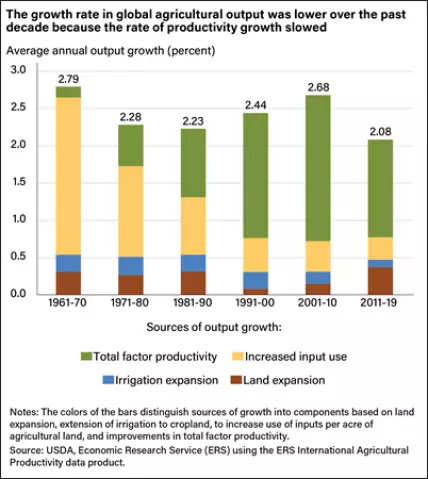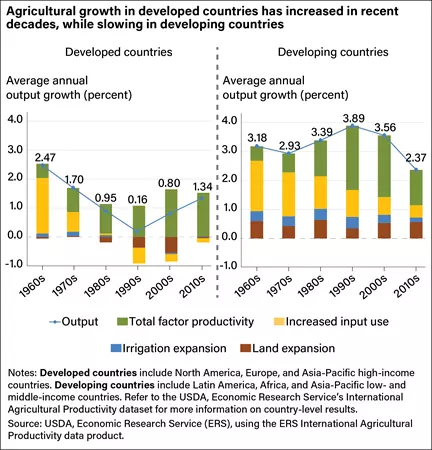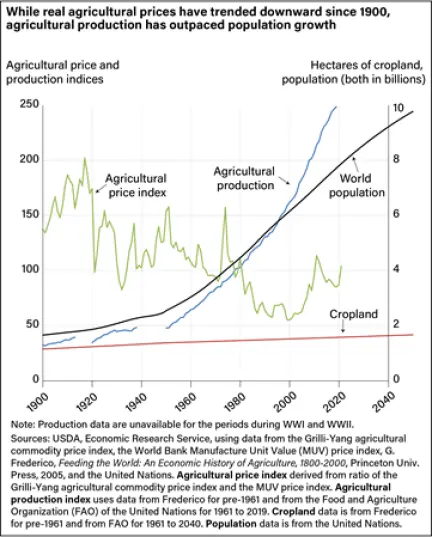Comments
- No comments found

Agricultural productivity growth is of central importance. In many of the lowest-income parts of the world, a majority of the local population is involved in subsistence farming.
A standard pattern of economic growth is that people move away from agriculture to manufacturing and services, and move away from rural areas to urban areas. In this process, agriculture itself shifts from a focus on food to output that are sources of fiber, energy and other industrial inputs, and items like cut flowers. Moreover, current predictions are that global population will peak a little short of 10 billion people in the 2060s, and then drop off to less than 9 billion by the end of the 21st century.
It’s also worth remembering that higher agricultural productivity can mean more output with less strain on resources of soil and water–and potentially with reduced use of pesticides as well.
Given the breakthroughs in understanding the genetics of plants and how to look after them, along with the gradual spread of these insights around the world, one might expect growth in agricultural productivity to be steady, or even robust. But when Keith Fuglie, Jeremy Jelliffe, and Stephen Morgan of the Economic Research Service at the US Department of Agriculture looked at the data, they find, “Slowing Productivity Reduces Growth in Global Agricultural Output” (Amber Waves, December 28, 2021).
To set the stage, here’s a measure of growth in global agricultural output over the decades. The breakdown shows that agricultural output can rise for a number of reasons: more land, more irrigation, more inputs like fertilizer. The gains in output that can’t be attributed to these other factors are a measure of productivity gains. Thus, you can see that while gains in agricultural input back in the 1960s and 1970s were largely due to higher inputs, there has been a shift over time to more importance of productivity growth. You can also see that the green bar of productivity growth is smaller in the most recent decade.

What patterns emerge when looking into this data more closely? Most of the decline in agricultural productivity growth, it turns out, is in the lower-income developing economies, while agricultural productivity growth in higher-income developed countries has stayed strong. The authors write: “In terms of productivity growth, Latin America and the Caribbean experienced the largest slowdown, followed by Asia. In Sub-Saharan Africa, agricultural productivity growth was already low in the 2000s and turned slightly negative in the 2010s.”

Here’s the overall pattern that emerges. The black line shows population, projected forward to 2040. The blue line shows agricultural production rising faster than population. The red line shows that cropland has risen, but not a lot. The green line shows a general (and occasionally interrupted) pattern of falling agricultural prices in late 20th century, with a price rise starting around 2000s.

There are theories about why agricultural productivity growth has been faring poorly in the developing countries that seem as if they should have the most room for gains. Perhaps the agricultural sector in those countries is less flexible and responsive to shifts in patterns of weather or crop disease. Some of the agricultural productivity gains in higher-income countries are based on customizing production using information and feedback from satellite, internet, and cellular infrastructure, which is less available in developing economies. Whatever the reason, the need to find ways of improving agricultural productivity in lower-income countries is vital and pressing.
Timothy Taylor is an American economist. He is managing editor of the Journal of Economic Perspectives, a quarterly academic journal produced at Macalester College and published by the American Economic Association. Taylor received his Bachelor of Arts degree from Haverford College and a master's degree in economics from Stanford University. At Stanford, he was winner of the award for excellent teaching in a large class (more than 30 students) given by the Associated Students of Stanford University. At Minnesota, he was named a Distinguished Lecturer by the Department of Economics and voted Teacher of the Year by the master's degree students at the Hubert H. Humphrey Institute of Public Affairs. Taylor has been a guest speaker for groups of teachers of high school economics, visiting diplomats from eastern Europe, talk-radio shows, and community groups. From 1989 to 1997, Professor Taylor wrote an economics opinion column for the San Jose Mercury-News. He has published multiple lectures on economics through The Teaching Company. With Rudolph Penner and Isabel Sawhill, he is co-author of Updating America's Social Contract (2000), whose first chapter provided an early radical centrist perspective, "An Agenda for the Radical Middle". Taylor is also the author of The Instant Economist: Everything You Need to Know About How the Economy Works, published by the Penguin Group in 2012. The fourth edition of Taylor's Principles of Economics textbook was published by Textbook Media in 2017.
Leave your comments
Post comment as a guest